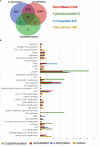Hydrogen Sulfide Signaling in Plants: Emerging Roles of Protein Persulfidation
- PMID: 30283480
- PMCID: PMC6157319
- DOI: 10.3389/fpls.2018.01369
Hydrogen Sulfide Signaling in Plants: Emerging Roles of Protein Persulfidation
Abstract
Hydrogen sulfide (H2S) has been largely referred as a toxic gas and environmental hazard, but recent years, it has emerged as an important gas-signaling molecule with effects on multiple physiological processes in both animal and plant systems. The regulatory functions of H2S in plants are involved in important processes such as the modulation of defense responses, plant growth and development, and the regulation of senescence and maturation. The main signaling pathway involving sulfide has been proven to be through protein persulfidation (alternatively called S-sulfhydration), in which the thiol group of cysteine (-SH) in proteins is modified into a persulfide group (-SSH). This modification may cause functional changes in protein activities, structures, and subcellular localizations of the target proteins. New shotgun proteomic approaches and bioinformatic analyses have revealed that persulfidated cysteines regulate important biological processes, highlighting their importance in cell signaling, since about one in 20 proteins in Arabidopsis is persulfidated. During oxidative stress, an increased persulfidation has been reported and speculated that persulfidation is the protective mechanism for protein oxidative damage. Nevertheless, cysteine residues are also oxidized to different post-translational modifications such S-nitrosylation or S-sulfenylation, which seems to be interconvertible. Thus, it must imply a tight cysteine redox regulation essential for cell survival. This review is aimed to focus on the current knowledge of protein persulfidation and addresses the regulation mechanisms that are disclosed based on the knowledge from other cysteine modifications.
Keywords: Arabidopsis; cell signaling; cysteine; hydrogen sulfide; persulfidation; post-translational modification; proteomic.
Figures

References
Publication types
LinkOut - more resources
Full Text Sources

